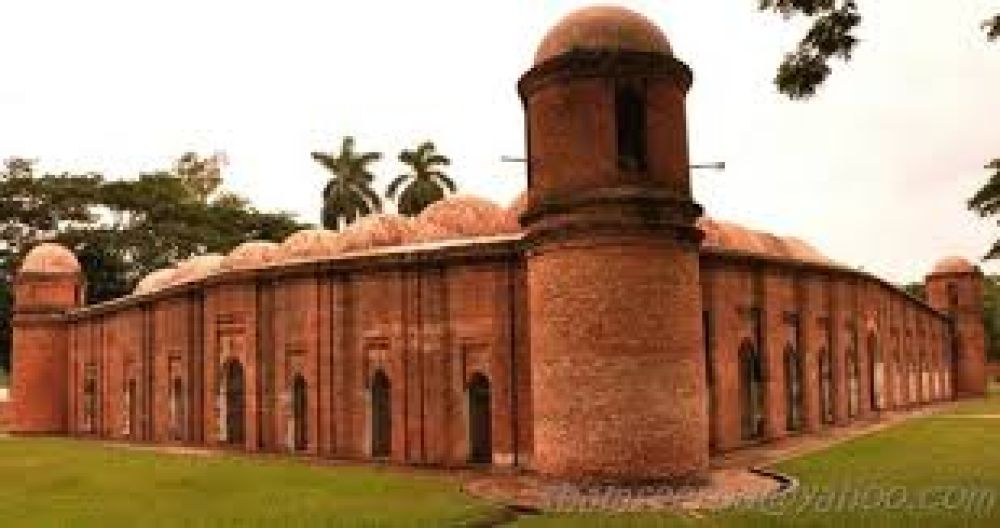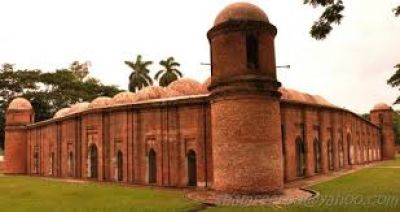

Embark on a historical journey with a guided tour of the Sixty Dome Mosque, a UNESCO World Heritage Site and one of Bangladesh's most impressive architectural wonders. This ancient mosque, built in the 15th century under the Sultanate of Bengal, features 60 pillars that support 77 domes, although it is commonly referred to by its misnomer 'Shat Gombuj', implying 60 domes. During the tour, you will learn about its rich history, the unique Bengali-Muslim architecture, and its significance as a mosque, madrasa, and mausoleum. Notice the intricate terracotta designs, the mosque's impressive dimensions, and learn about the daily life of Sultanate-era Bengal. The guide will also share stories and insights about the mosque's builder, Khan Jahan Ali, and his influence on the region.
Capture the timeless beauty of the Sixty Dome Mosque with a dedicated photography session. Photographers, both amateur and professional, are welcome to explore the site and take stunning images of this iconic structure and its surroundings. The play of light at different times of the day creates unique opportunities for spectacular photographs. You can also take portraits framed by the historical site or the traditional life that coexists alongside this ancient monument. This activity provides enthusiasts with the chance to document the patterns, textures, and atmosphere of the mosque. Please be respectful and abide by any local cultural sensitivities regarding photography within the premise.
Discover the area around Shat Gombuj Mosque with a cultural heritage walk. The walk takes you through the nearby sites related to Khan Jahan Ali, including the Thakur Dighi (a large tank), the mausoleums of Muslim saints, and other smaller mosques around Bagerhat. Learn about the synthesis of Islamic and Bengali architectural styles, and how the city was once a thriving medieval city that has now largely returned to nature. The route is a journey through time, uncovering the layers of history that have contributed to the region's cultural landscape.
End your day with a peaceful sunset by the Thakur Dighi, the large tank near the Sixty Dome Mosque. This tranquil activity allows you to unwind and enjoy the serene beauty of the tank's waters reflecting the colors of the setting sun. It’s also a popular local activity, so it's an excellent opportunity for cultural exchange and to observe local life. Bring a camera to capture the stunning sunset, and perhaps even a picnic to enhance the experience.
Focus on the artistic elements of Islamic culture with a calligraphy and inscription study activity. You'll see the engravings and calligraphic inscriptions on the mosque stones that reveal verses from the Quran, details about the mosque’s construction, and insights into the cultural heritage of the area. These elements are not only deeply spiritual but also an art form highlighting the skill and tradition of the time. A local expert can explain the significance and translate these beautiful works for visitors interested in the deeper aspects of the mosque’s history.
A visit to the museum near Shat Gombuj Mosque offers a deeper understanding of the historical and archaeological context of the mosque. The museum houses artefacts, models, and exhibits that depict the lifestyle, culture, and architectural heritage of the Sultanate period in Bengal. Visitors can learn about the various stages of the mosque's construction, the materials used, and the daily activities that took place in the mosque complex. Additionally, it provides a socio-economic overview of the region during the time of Khan Jahan Ali.
Experience the spiritual ambience of Shat Gombuj Mosque by attending a prayer session. Visitors are welcome to observe or, if they are of the Islamic faith, participate in the communal prayer sessions that take place five times a day. It's a moment to witness the continuation of centuries-old religious traditions and the community that has been gathered around this mosque for generations. Please note that visitors are expected to dress modestly out of respect for the religious site and its congregants.
No visit to Bagerhat is complete without trying out the local cuisine. Outside the precincts of the Shat Gombuj Mosque, you'll find vendors and small eateries serving traditional Bangladeshi snacks and meals. Indulge in rice-based dishes, spicy curries, fresh fish from the region, and traditional sweets like roshogolla. Taste test different street food items, and with permission from the vendors, you might even peek behind the scenes to see how these culinary delights are prepared.
Near the Shat Gombuj Mosque, the legacy of the skilled artisans of the Sultanate era continues through the work of local craftspeople. Take a tour of the workshops or stalls where craftsmen display their trade, be it pottery, weaving, or woodworking. This glimpse into the traditional craftsmanship offers unique insights into the local culture and craftsmanship passed down through generations. Visitors can also purchase handicrafts as souvenirs, supporting the local economy.
While not in the immediate vicinity of the mosque, the Sundarbans—a UNESCO World Heritage site—is close enough to warrant a day trip for nature enthusiasts. It’s the world's largest mangrove forest and home to the famous Royal Bengal Tiger. A walk or boat trip through this unique ecosystem allows visitors to experience exotic wildlife, lush vegetation, and serene landscapes. Although a visit to Sundarbans requires a whole day and should be pre-planned, it perfectly complements the cultural experience provided by the Shat Gombuj Mosque.
